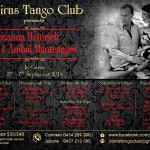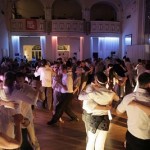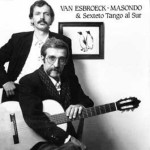Dirk van Esbroek was a flemish composer, guitar player and poet, born in Argentina in 1946, who moved back to Belgium in 1964. In the 70ies, he met the Argentinean guitar player Juan Masondo and concentrated on south American music. Together with bandoneon player Alfredo Marcucci they formed a Trio, which later grew into the Sexteto Tango al Sur. Later, he also played in the production of Maria de Buenos Aires, a tango opera from Astor Piazzolla and Horacio Ferrer [1].
Continue Reading →
Tango Terminology, Communication and Choreography
Typically whenever I have lessons with other teachers, I ask for the naming convention of steps. I can´t help – I am a German scientist and I believe that it is very important to talk the same precise and descriptive language. The language of Tango, of course, is leading and following, good balance and projection and caring for our precious partners. Without this language, there is no real tango. Tango is all about communication and finding a nonverbal way of communication and connection. This is what we love and this is, what we constantly strive for. Typically half of my private lessons and half of my own training, I use to perfect my abilities and to overcome my depression when I only make slow progress.
During practicing and teaching, it is important to talk about Tango and now, the problems arise. There seems to be not very much common language in tango talk. Especially asking Argentinean teachers about naming conventions is frustrating, because they typically either do not know or refer to the traditional Argentinean teaching method of just copying teacher´s examples.
El Adiós
This is one of the important Tangos, well known and performed by many artists. As a DJ, my typical feeling is that this is one of the golden songs, frequently played and asked for. I have never looked into the text and really do not know who wrote the title and who actually has sung it, so let us look a bit deeper into this matter. (BTW: If you do not know the song, further down, you can find some videos with the music).

12/09/2014
by Richard Stoll
0 comments
Tengo una pregunta para vos
“Tengo una pregunta para vos” (translated: I have a question for you) is not a spanish course nor a TV show. It is a series of public interviews conducted by Pepa Palazon and hosted at DNI (Tango school, Bulnes 1011) in Buenos Aires. Continue Reading →

10/09/2014
by Richard Stoll
0 comments
Tango DJing Part 7: Video DJing, Update 2014
Letztes Jahr habe ich darüber gebloggt, wie praktisch ein Videoprojektor für einen DJ sein kann. Während meines letzten Besuchs in Deutschland habe ich einige andere DJs gesehen, die Video benutzen, also habe ich beschlossen, dieser Spur ein bisschen weiter zu folgen. Darüber hinaus sind im Internet mehr Videos aus vielen Quellen verfügbar und auch mehr DJ-Programme können für VJing gefunden werden. Da wir letzte Woche ein großes Festival mit 4 Milongas (einer davon eine Nuevo Milonga) hatten, möchte ich hier meine Ausrüstung und Einrichtung für eine verbesserte Videointegration vorstellen. Continue Reading →

10/09/2014
by Richard Stoll
0 comments
Tango DJing Part 7: Video DJing, Update 2014
VJing for Milongas
Last year, I have blogged about how handy a video projector can be for a DJ. During my last visit in Germany, I have seen some other DJs using video, so I have decided to follow that lane a bit further. Additionally, more videos are available on the internet from many sources and also more DJ programs can actually be found for VJing. As we had a big festival last week with 4 Milongas (one of them a Nuevo Milonga), I would like to present here my equipment and setup for improved video integration. Continue Reading →

29/08/2014
by Richard Stoll
0 comments
Cairns Tango Festival

28/08/2014
by Richard Stoll
0 comments
OT Misteriosa Buenos Aires
Among the many Orchestras in BsAs those are interesting who play tango for dancers. Visiting the small and bigger milongas there, you will frequently find these orchestras playing for some tangos and for the dancing crowd. At La Viruta (Armenia 1366) or Salon Canning (Av. Raul Scalabrini Ortiz 1331) you may frequently see OT Misteriosa Buenos Aires.
Continue Reading →

20/08/2014
by Richard Stoll
0 comments
Milonga Nueva
First we have to remember that a Milonga is a place for dancers to dance and have fun in a social context. Milongas in BsAs are very formal and sometimes frozen in tradition, so typically they are crowded and the dancing style has been adjusted to this fact, so for example, everybody is doing close embrace tango for limited space and music is typically limited to golden age tangos.
Internationally, Milongas may be more free, so there may be tandas of modern tango and even Tango Nuevo. There are also tandas of modern style music (NonTango) or even Salsa and Chacarera. In the big cities like Berlin or Munich, there are also special events for Neotango Music. Such events follow their own rules. Here is a list of things you may expect at a Milonga Nueva: Continue Reading →

12/08/2014
by Richard Stoll
0 comments
Listening to Tango Music
Hi all,
whenever I listen to a Tango song, I hear some new details I have never before noticed. Tango music can be simple or extremely sophisticated, so I have always been in search of a good structured method to approach this problem of actively listening and analyzing a Tango. Yesterday I found this very interesting article of Michael Lavocah on TodoTango (my favorite Tango Website): “Listening to Tango Music – A beginners guide”. Continue Reading →




